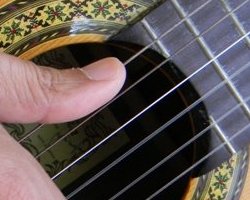All four Gospels record the ministry of John the Baptist’s testifying to Jesus (Matt. 3; Mark 1; Luke 3; John 1). Through his ministry, who did John identify Jesus to be?
John 1 informs us that John identified Jesus to be the following: the Light (1:7); the One who was before him (1:15, 30); the LORD (1:23); the Lamb of God (1:29); the One who baptizes with the Holy Spirit (1:33); and the Son of God (1:34). Although most believers have understood that John identified Jesus in these ways, there is at least one more way that he seems to have identified Him that many may not have seen.
This likely additional identification pertains to John’s testimony that he “saw the Spirit descending from heaven like a dove and it abode upon Him” (1:32). He added, “I knew Him not, but He that sent me to baptize with water, the Same said unto me, ‘Upon Whom thou shalt see the Spirit descending, and remaining on Him, the Same is He which baptizeth with the Holy Ghost.’ And I saw and bare record that this is the Son of God” (1:34).
These statements show that John testified about Jesus as the Son of God who baptizes with the Holy Spirit. They also, however, speak of the Spirit’s abiding on Him by using the verb μένω (I am abiding) twice:
BGT John 1:32 Καὶ ἐμαρτύρησεν Ἰωάννης λέγων ὅτι τεθέαμαι τὸ πνεῦμα καταβαῖνον ὡς περιστερὰν ἐξ οὐρανοῦ καὶ ἔμεινεν ἐπ᾽ αὐτόν. 33 κἀγὼ οὐκ ᾔδειν αὐτόν, ἀλλ᾽ ὁ πέμψας με βαπτίζειν ἐν ὕδατι ἐκεῖνός μοι εἶπεν• ἐφ᾽ ὃν ἂν ἴδῃς τὸ πνεῦμα καταβαῖνον καὶ μένον ἐπ᾽ αὐτόν, οὗτός ἐστιν ὁ βαπτίζων ἐν πνεύματι ἁγίῳ.
SCR John 1:32 καὶ ἐμαρτύρησεν Ἰωάννης, λέγων ὅτι Τεθέαμαι τὸ Πνεῦμα καταβαῖνον ὡσεὶ περιστερὰν ἐξ οὐρανοῦ, καὶ ἔμεινεν ἐπ᾽ αὐτόν. 33 κἀγὼ οὐκ ᾔδειν αὐτόν• ἀλλ᾽ ὁ πέμψας με βαπτίζειν ἐν ὕδατι, ἐκεῖνός μοι εἶπεν, Ἐφ᾽ ὃν ἂν ἴδῃς τὸ Πνεῦμα καταβαῖνον καὶ μένον ἐπ᾽ αὐτόν, οὗτός ἐστιν ὁ βαπτίζων ἐν Πνεύματι Ἁγίῳ.
NAU John 1:32 John testified saying, “I have seen the Spirit descending as a dove out of heaven, and He remained upon Him. 33 “I did not recognize Him, but He who sent me to baptize in water said to me, ‘He upon whom you see the Spirit descending and remaining upon Him, this is the One who baptizes in the Holy Spirit.’
KJV John 1:32 And John bare record, saying, I saw the Spirit descending from heaven like a dove, and it abode upon him. 33 And I knew him not: but he that sent me to baptize with water, the same said unto me, Upon whom thou shalt see the Spirit descending, and remaining on him, the same is he which baptizeth with the Holy Ghost.
The second occurrence emphasizes that abiding by using a present participle (μένον) to express the continuing nature of that abiding.
A comparison of the teaching of a key OT passage about the Messiah with these statements reveals an important conceptual parallel:
LXE Isaiah 11:2 and the Spirit of God shall rest upon him, the spirit of wisdom and understanding, the spirit of counsel and strength, the spirit of knowledge and godliness shall fill him;
BGT Isaiah 11:2 καὶ ἀναπαύσεται ἐπ᾽ αὐτὸν πνεῦμα τοῦ θεοῦ πνεῦμα σοφίας καὶ συνέσεως πνεῦμα βουλῆς καὶ ἰσχύος πνεῦμα γνώσεως καὶ εὐσεβείας
NAU Isaiah 11:2 The Spirit of the LORD will rest on Him, The spirit of wisdom and understanding, The spirit of counsel and strength, The spirit of knowledge and the fear of the LORD.
KJV Isaiah 11:2 And the spirit of the LORD shall rest upon him, the spirit of wisdom and understanding, the spirit of counsel and might, the spirit of knowledge and of the fear of the LORD;
Although Isaiah 11:2 in the LXX uses the verb ἀναπαύω instead of μένω, it appears that they are communicating the same concept in these statements. John the Baptist thus identified Jesus to be the Rod and Branch of Isaiah 11!
Support for this interpretation comes from the strong conceptual parallel between the further teaching of Isaiah 11 and John’s testimony to Jesus recorded in Luke 3:
“And shall make Him of quick understanding in the fear of the LORD: and He shall not judge after the sight of His eyes, neither reprove after the hearing of His ears: 4 But with righteousness shall He judge the poor, and reprove with equity for the meek of the earth: and He shall smite the earth with the rod of His mouth, and with the breath of His lips shall He slay the wicked” (Isa. 11:3-4).
“Whose fan is in His hand, and He will throughly purge his floor, and will gather the wheat into his garner; but the chaff He will burn with fire unquenchable” (Luke 3:17).
These passages show both the Rod and Branch who had the Spirit resting upon Him (Isa. 11) and the Christ upon whom the Spirit remained (John 1; Luke 3) rendering judgment on both the righteous (“the poor”; “the meek of the earth”; “the wheat”) and the wicked (“the wicked”; “the chaff”).
This analysis thus shows that John the Baptist testified to Jesus as the Spirit-Anointed Rod and Branch who is God’s judicial Agent!
Copyright © 2011-2025 by Rajesh Gandhi. All rights reserved.







